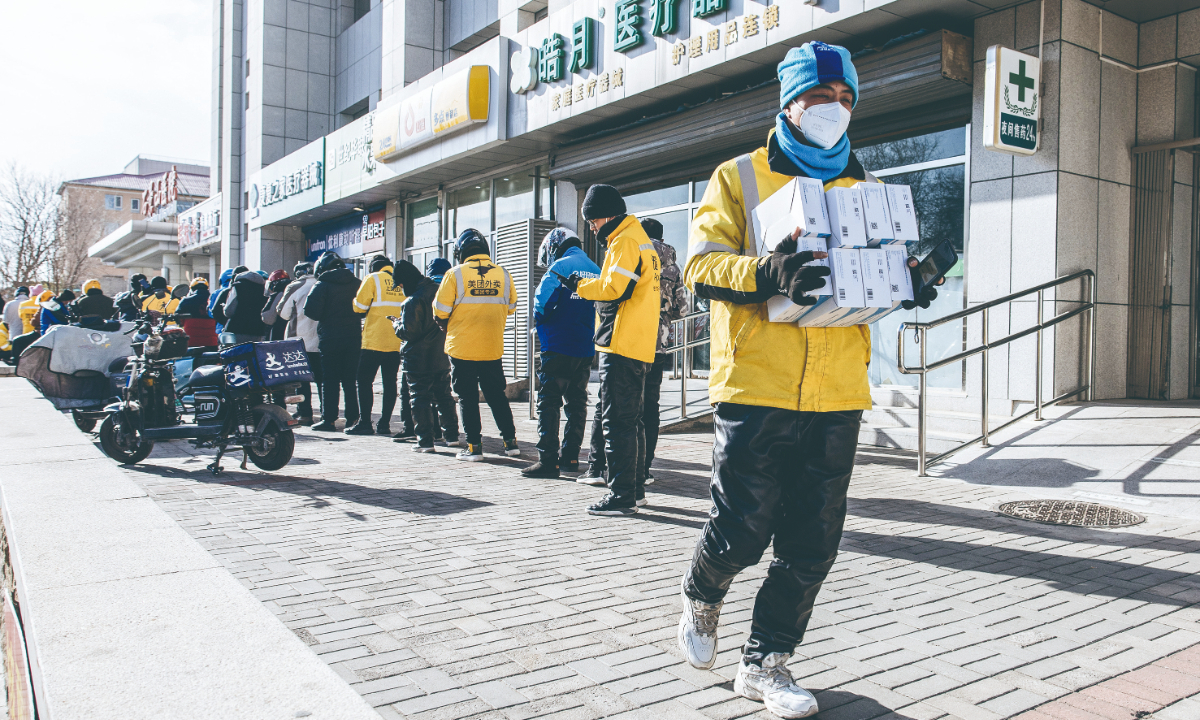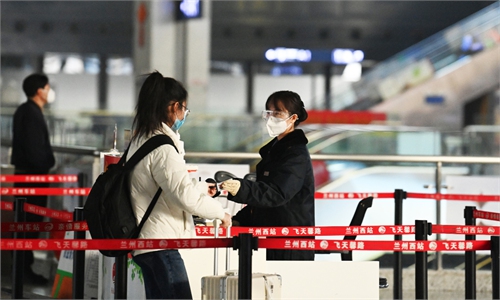China pivots from curbing infection to medical treatment, guarantees safe re-opening

Delivery personnel dispatch COVID-19 antigen kits and medicines for fever, cold and cough as demand surges on December 8, 2022, after restrictions on drug purchases were lifted. Many pharmacies and drug producers are scrambling to ramp up supply in response. Photo: Li Hao/GT
China stopped counting the daily tally of asymptomatic COVID-19 cases starting on Wednesday, and at the same time rolled out second booster shots for vulnerable groups, including the elderly and those with chronic diseases, and doubled down on ensuring the public's needs for medicine and medical care.
Those moves further push the focus of China's COVID-19 fight from curbing off infection to shoring up resources to bolster the medical system for the first exit wave, a key step that guarantees a safe and orderly re-opening for the country, said epidemiologists.
The short period of strained medical resources and short supply of COVID-19 materials will eventually be weathered with Chinese people's cooperation, solidarity, and the government's top-down coordination efforts, said experts. They believe China's road to re-opening will be "safe and orderly," instead of what foreign media has described as "bumpy." The country only relaxed restrictions when the virus was less lethal and preparations were in place, unlike Western countries that were forced to surrender in face of even deadly variants.
The country will stop reporting asymptomatic COVID-19 cases starting from Wednesday because it is hard to gauge the number of those infected without symptoms in the absence of testing statistics, the National Health Commission said in a statement on Wednesday.
Li Qun, director of the Emergency Center of the Chinese Center for Disease Control and Prevention (China CDC), explained that not only are silent carriers no longer participating in nucleic tests, after China released 10 new measures that scrapped the need for massing testing, they do not need to be treated in medical institutes. Thus there's no need to report those cases, said Li, noting that this group will still do health monitoring at home, under guidance and services from the grass-root medical institutions.
In the long run, COVID-19 management will eventually be downgraded to Class C management, putting it on par with influenza, which has high transmissibility yet no need for every patient to be treated at hospital, Zeng Guang, former chief epidemiologist from the CDC told the Global Times.
Treating COVID-19 like flu and no longer reporting nor managing cases with mild symptoms means that medical resources can be concentrated on saving severe cases, Zeng said.
COVID-19 was classified as a Class B infectious disease on January 20, 2020, a day after Beijing identified it could spread from between humans. However, the announcement noted that it should be managed like a category A disease, putting it on par with bubonic plague and cholera.
Li said that although the daily tally of silent carriers will no longer be reported, COVID-19 infections will still be monitored in various systems, such as the flu monitoring mechanism, to study the infection curve of the coronavirus and provide scientific data for further decision-making.
The same day, the NHC also rolled out a plan for second COVID-19 vaccine booster shots for high-risk groups and seniors over 60 years old. It said people who can take the second booster shot will include those with serious underlying conditions and those with low immunity.
As of Tuesday, 86.6 percent of those aged above 60 in China had completed a full course of vaccination (two shots), and 69 percent had received first booster shot (third shot); 66.4 percent of those aged over 80 had completed the full-course vaccination and 42.3 percent had a booster shot, Xia Gang, an NHC official in charge of immunization services said at a Wednesday conference.
Now resources should be concentrated on protecting vulnerable groups and guaranteeing treatment of severe cases and preventing deaths, Zeng said.
Pivot to medical treatment
Chinese Vice Premier Sun Chunlan on Tuesday also stressed the importance of meticulously implementing various measures to optimize COVID-19 prevention and control, and ensuring the smooth transition of the country's COVID-19 response phases.
COVID-19 cases began to surge after China released 10 new measures optimizing its COVID-19 response last week, and many epidemiologists predicted the first exit wave would peak within a month. Beijing is the first to shoulder the onslaught of the wave.
Beijing's infection number is hard to gauge as many people have stopped testing. Yet a public account on Chinese popular messaging app WeChat conducted a survey including 8,023 people, and 51 percent said they had tested positive as of Wednesday morning.
The capital's second-class hospitals reported 19,000 patients with flu-like symptoms last week, an official said on Monday. Also pharmacies are running out of medicines for treating flu in recent days.
In order to cope with the strained medical system, Beijing has expanded the number of fever clinics from 94 to 303 on Tuesday, and the city urged patients with mild symptoms to recover at home. Many patients with mild symptoms in the capital are treating themselves at home and they are "leaving the precious medical system to those in need," said resident Mavis Zhang, who was recently infected with the virus.
A Beijing resident who only gave his name as Feng said that he went to fever clinic of Beijing's Chaoyang Hospital on Tuesday night. He expected a long line as media reported over the weekend people had waited for more than six hours to be received at the clinic. "There were a few dozen people, mostly elderly, waiting outside of the clinic, in a very orderly manner… doctors were also calm. But sometimes I heard the doctors coughing, I feel like they are also having hard time," said Feng.
A doctor in a Beijing hospital told the Global Times that his hospital has dispatched more people to the fever clinic this week and designated a "red zone" for patients with COVID-19. The "red zone" wards are designed especially for pregnant women, and people with chronic diseases or with severe symptoms.
Nationwide, hospitals of second level and above opened more than 14,000 fever clinics as of Wednesday; on the grass-roots level, there are 33,000 such clinics, said another NHC official, noting waiting time outside the clinic in some places has reduced from the previous average of four hours to just 40 minutes.
After complaints about shortages of medicines, five large pharmaceutical firms in Beijing have ramped up production and dispatched 3.5 million boxes of COVID-19 related medicines to thousands of medical institutes and pharmacies in Beijing.
'Orderly and safe' adjustment
Ever since China optimized its COVID-19 response last week, foreign media began another round of smearing campaign, depicting it as China having failed to contain the virus and is ill-prepared for the exit wave. The Financial Times even "modeled" that "One million Chinese people are at risk of dying from COVID-19 during the coming winter months" due to relaxed policies.
Wang Guangfa, a respiratory expert from Peking University First Hospital, told the Global Times that China's relaxation of its COVID-19 policies is not the same as Western countries' lying flat in previous years. "They gave up because they didn't have our system of keeping the virus at bay by mass testing and static management. Omicron transmits faster, but it has relatively low pathogenicity. If we still used the old way to cope with the Omicron wave, the price will be unbearable," Wang said.
"We waited for three years to reopen with abundant backup plans to cope with the exit wave, they were forced to surrender in face of much dangerous variants such as Delta," Wang.
The death rate from Omicron is around 0.1 percent, similar to the common flu, and the infection rarely reaches the lungs, China's top epidemiologist Zhong Nanshan told the Xinhua News Agency last week. Most people recover from the variant within seven to 10 days, he said.
Moreover, China is upping the ante on its preparations. Hospitals nationwide are striving to shore up their preparedness for possible exit waves. An official from the NHC said last week that hospitals have moved quickly in recent days to increase ICU beds, more than doubling intensive care bed capacity to 10 beds per 100,000 people, up from less than four just a month ago.
Responding to the hypothesis that tens of thousands of people could die in the Chinese mainland, in reference to the death rate of Hong Kong's deadly fifth COVID-19 wave earlier in the year, Zhong, the renowned epidemiologist, brushed aside the scenario. He said that when the wave hit Hong Kong, less than 20 percent of those aged above 60 in the city was fully vaccinated. Yet 68.86 percent of the age group in the mainland had received a booster shot as of December 8. "It is far from enough, but it is surely better than Hong Kong back then," Zhong said.

